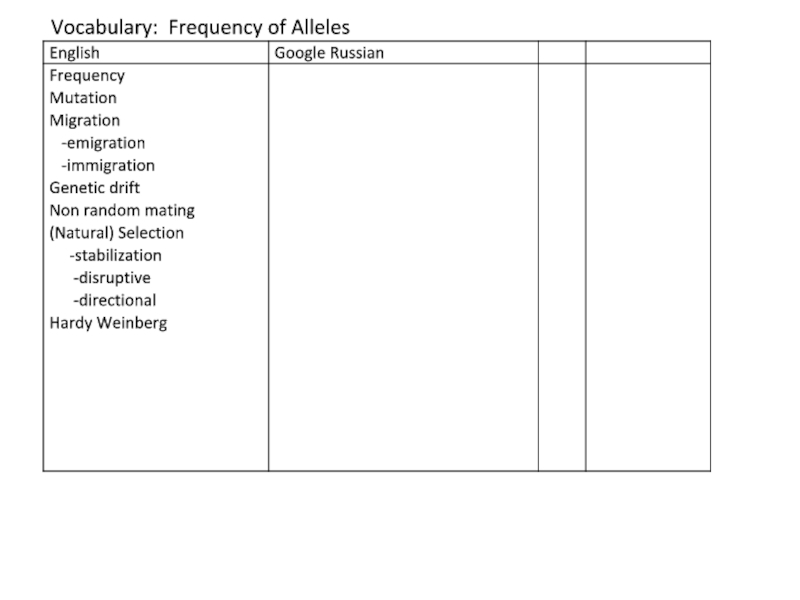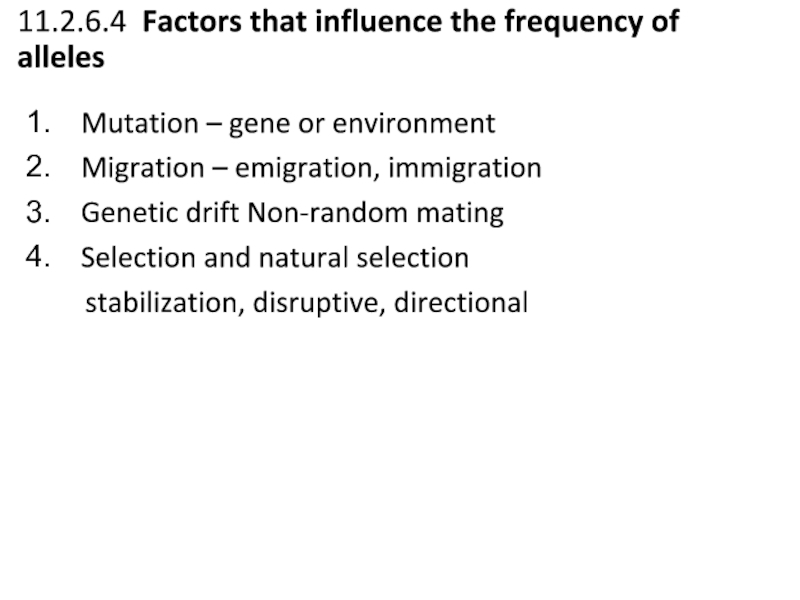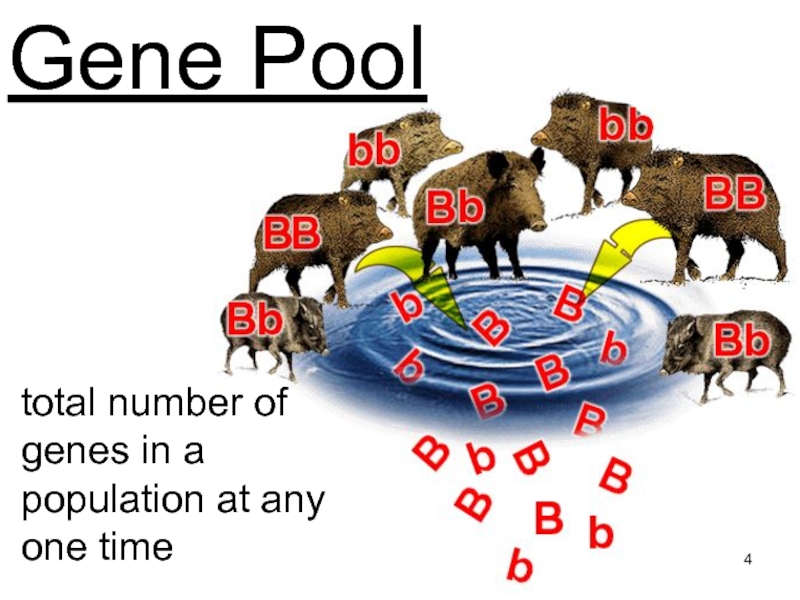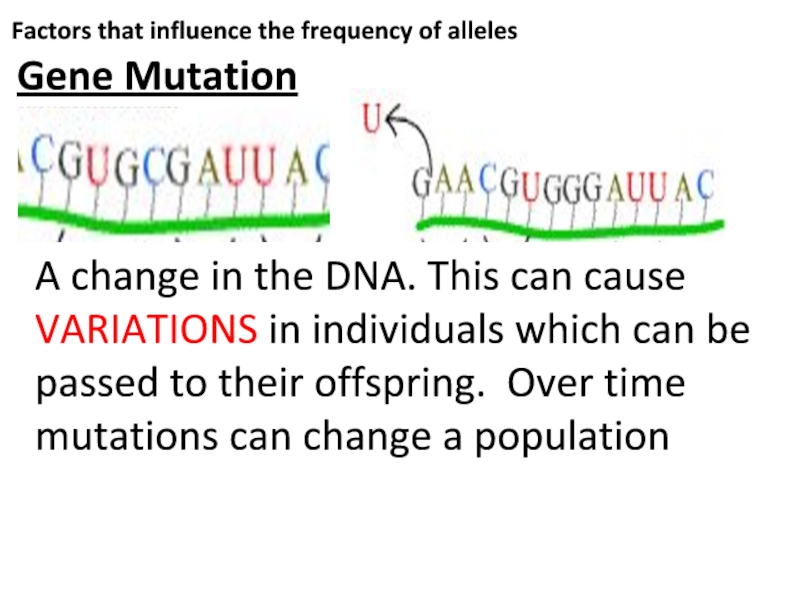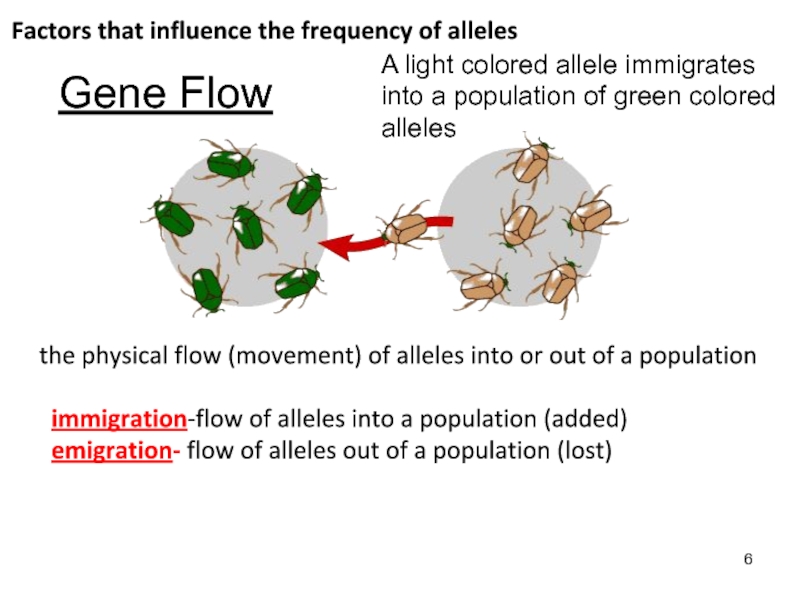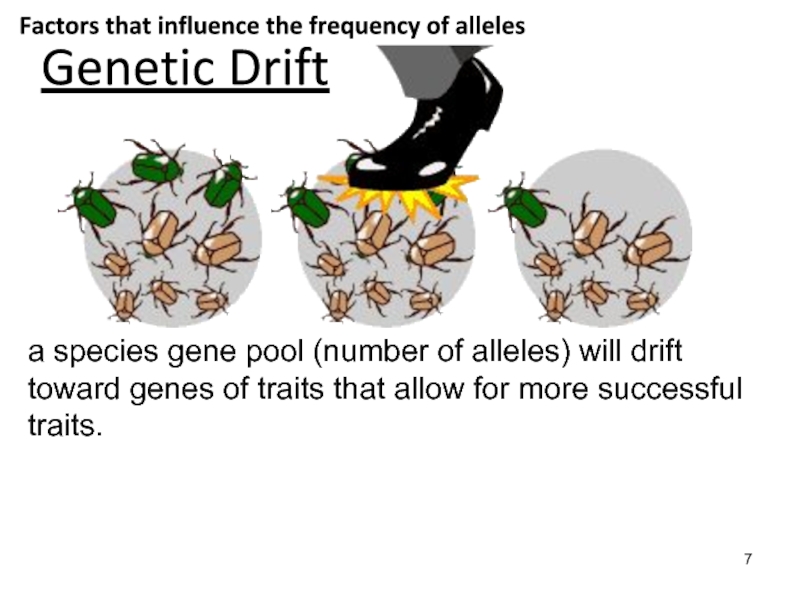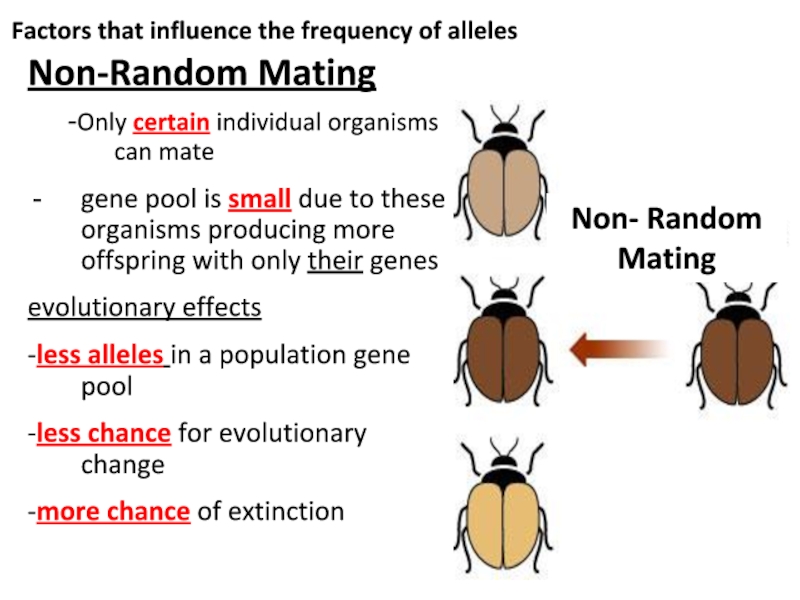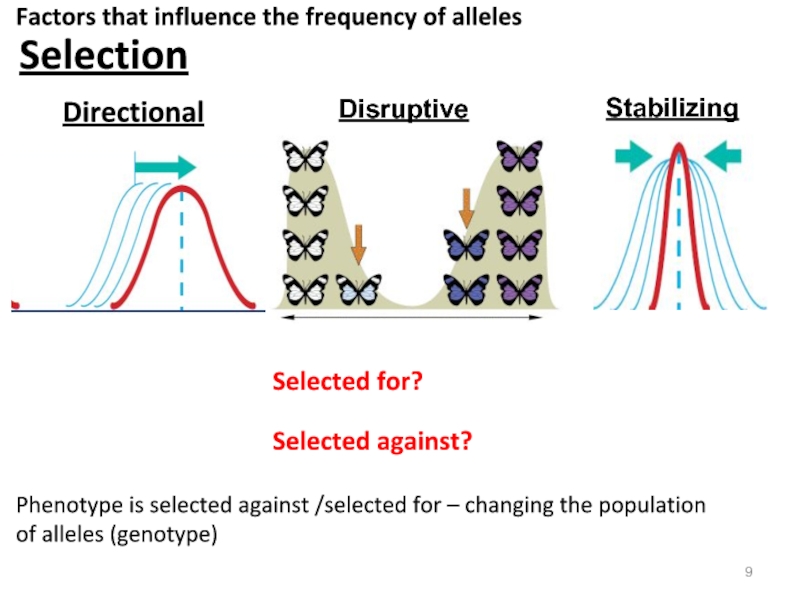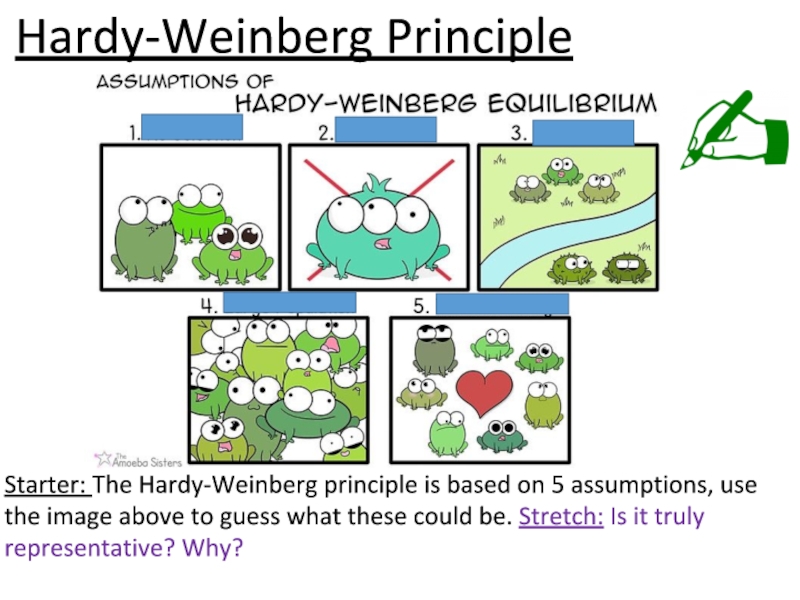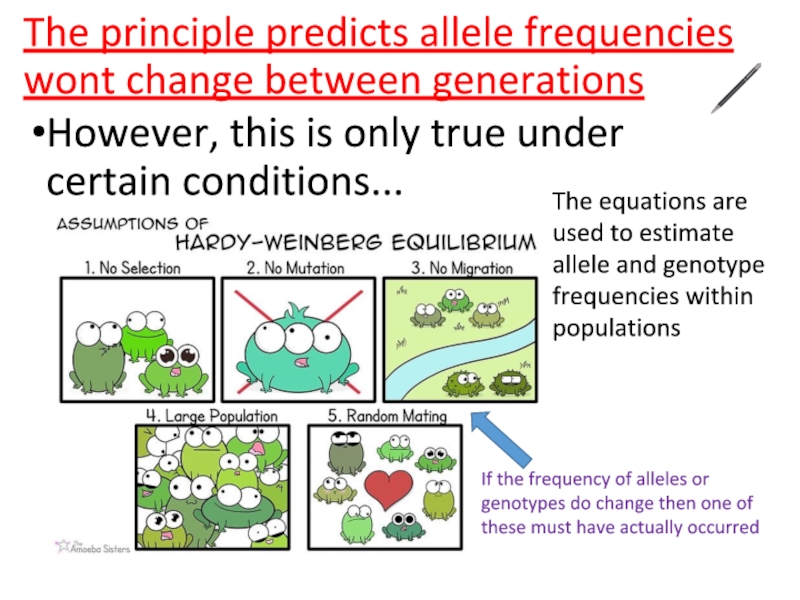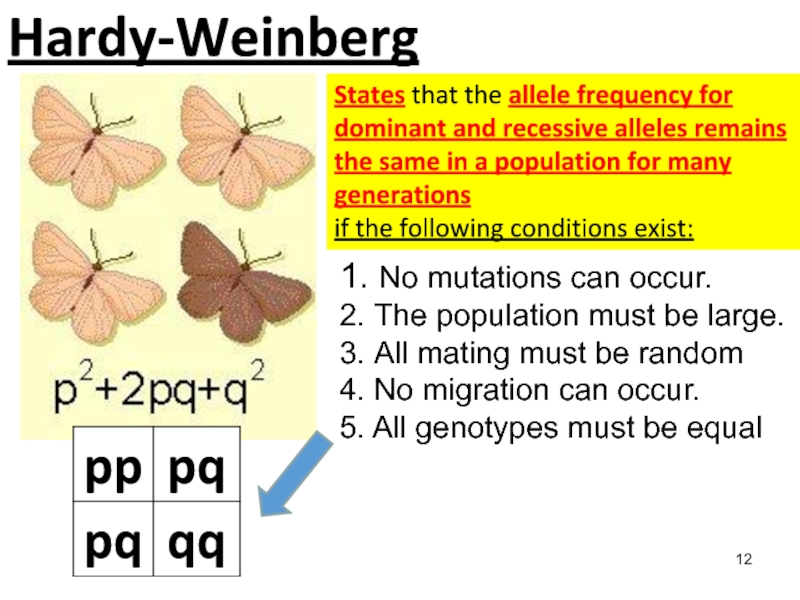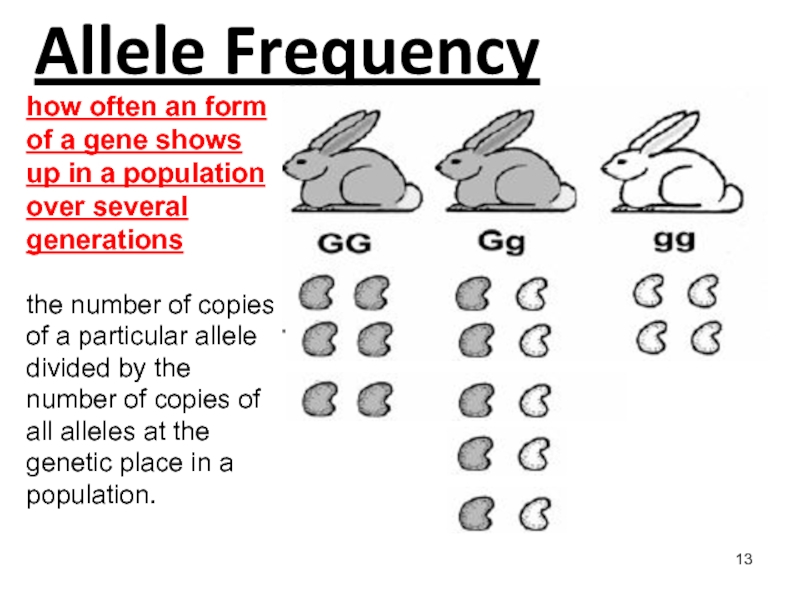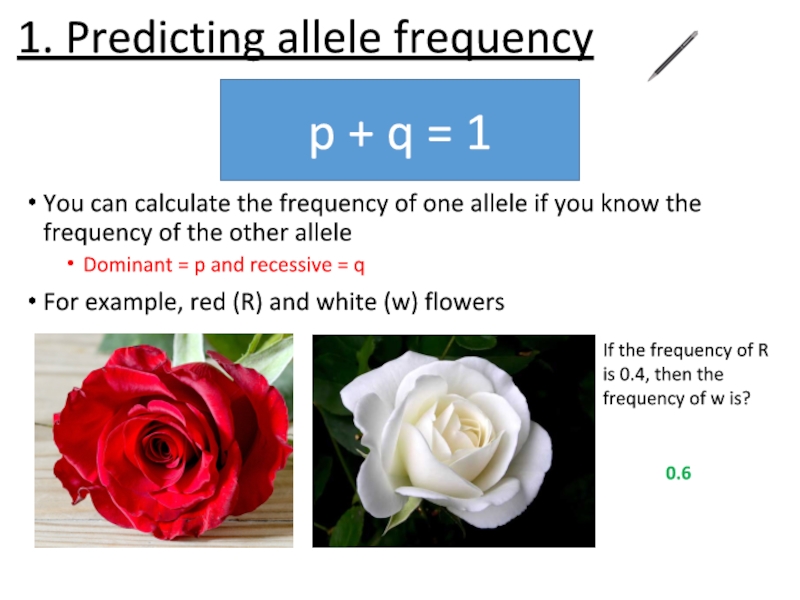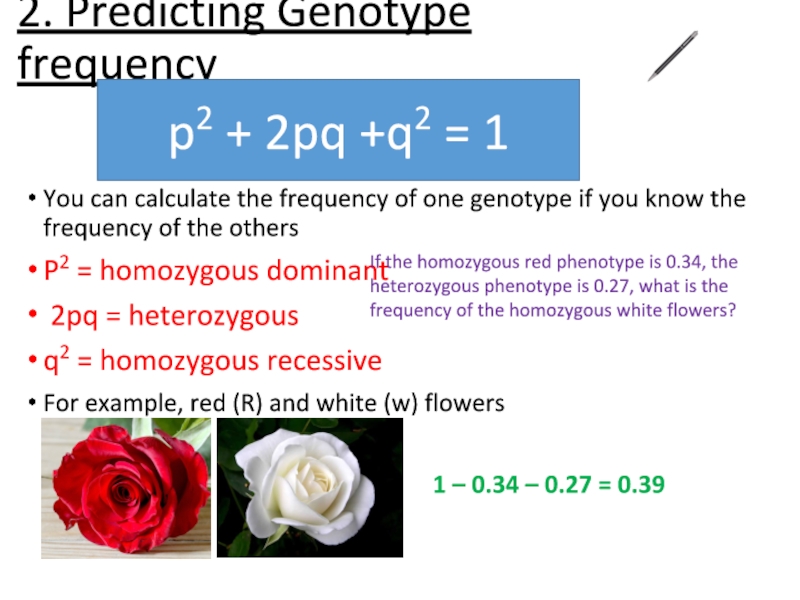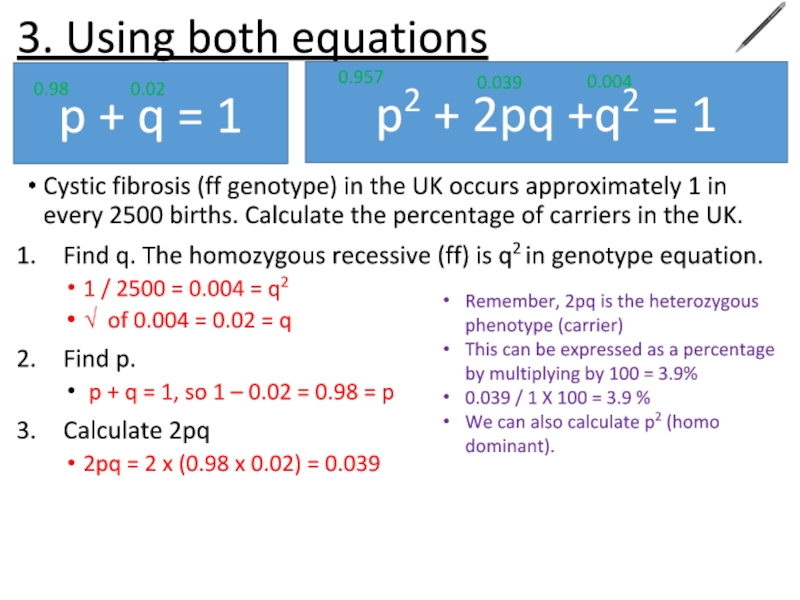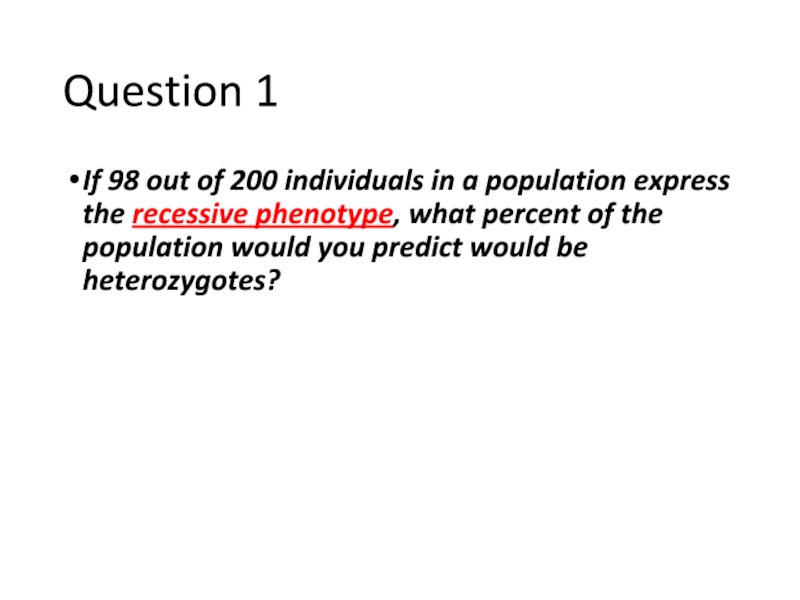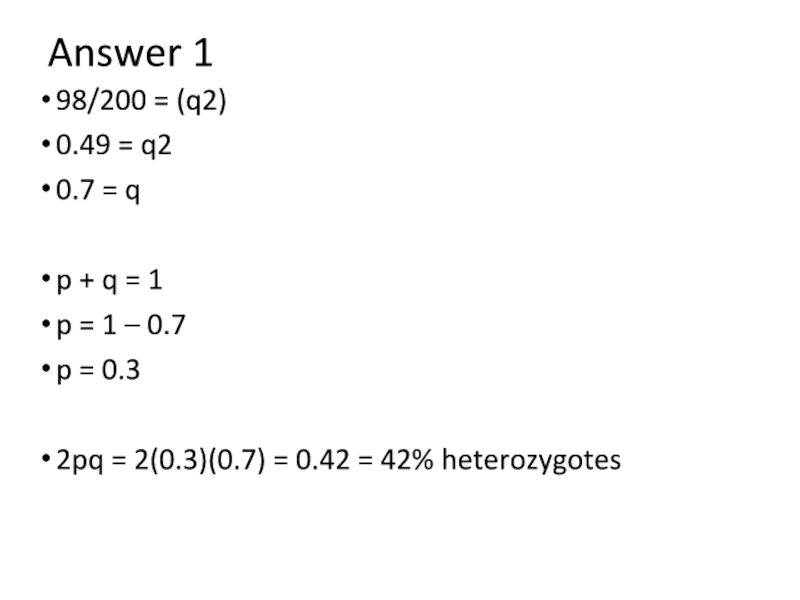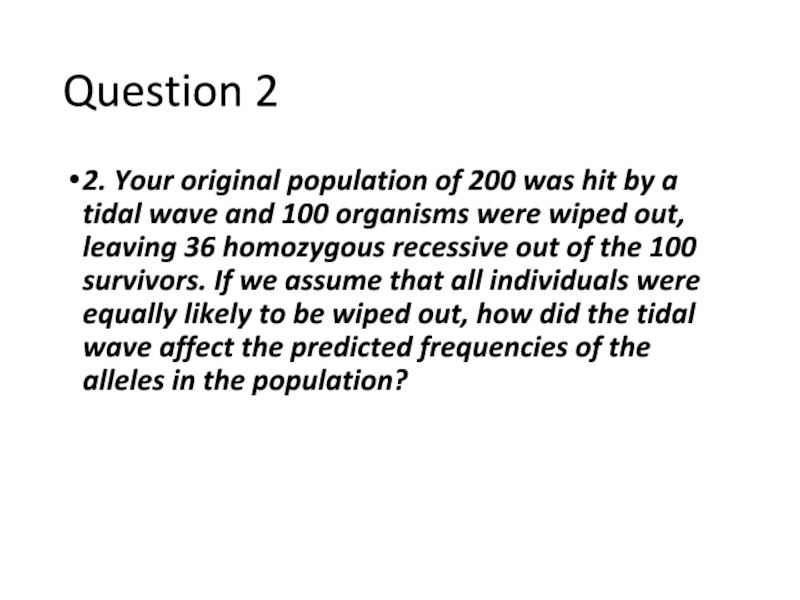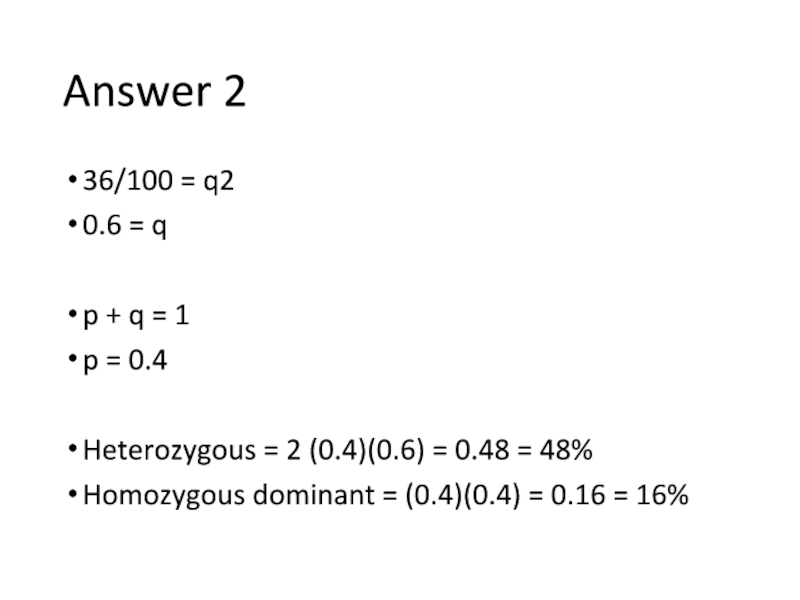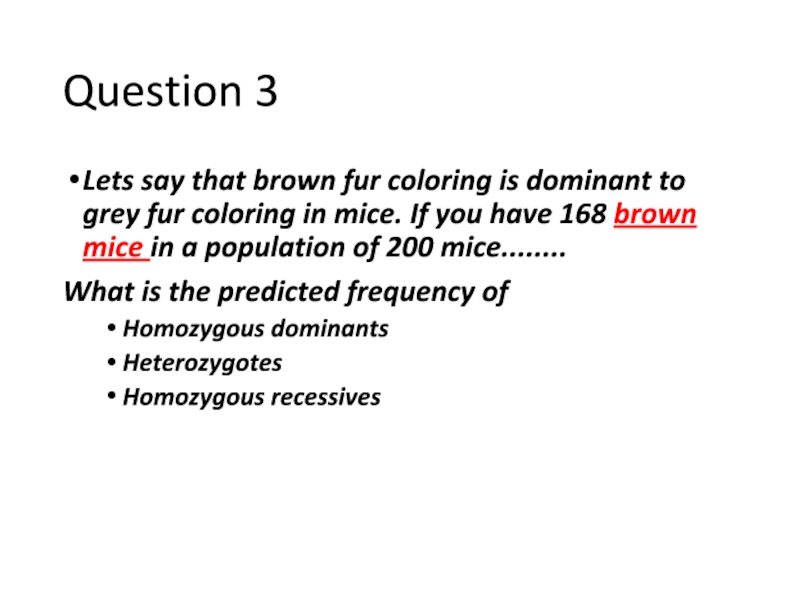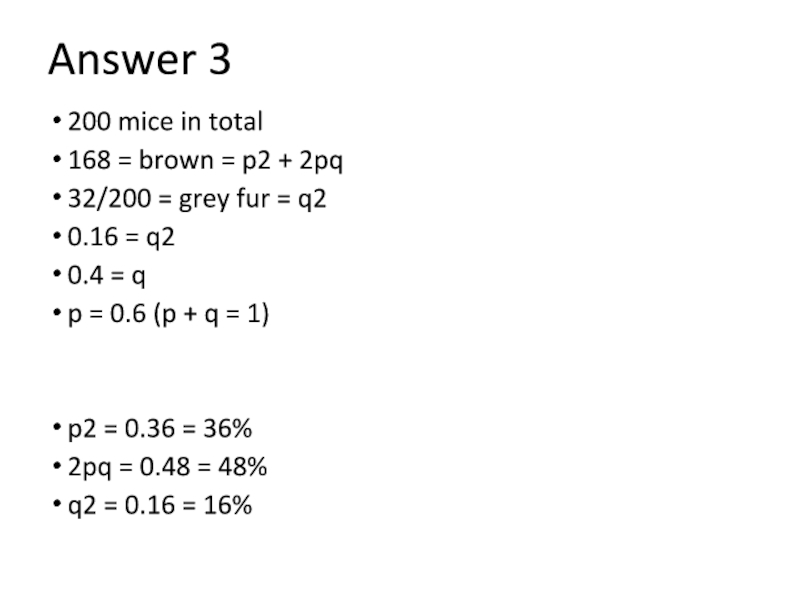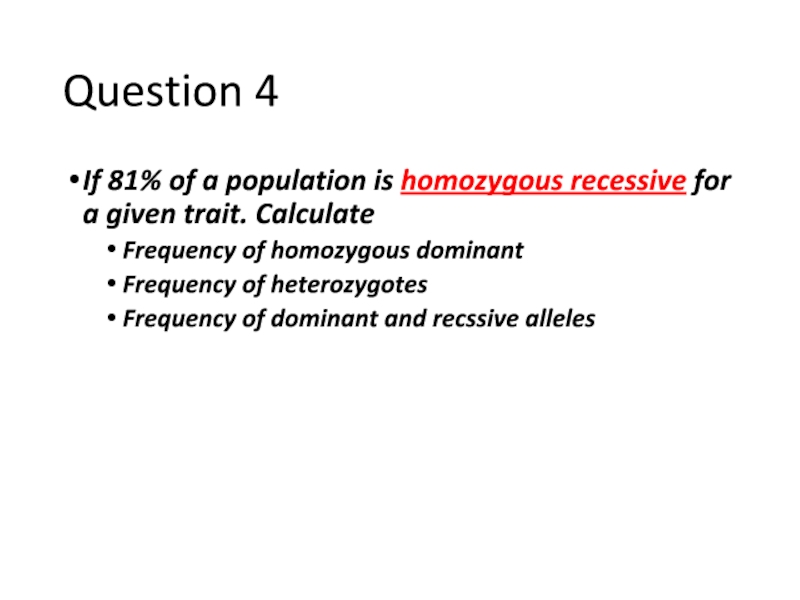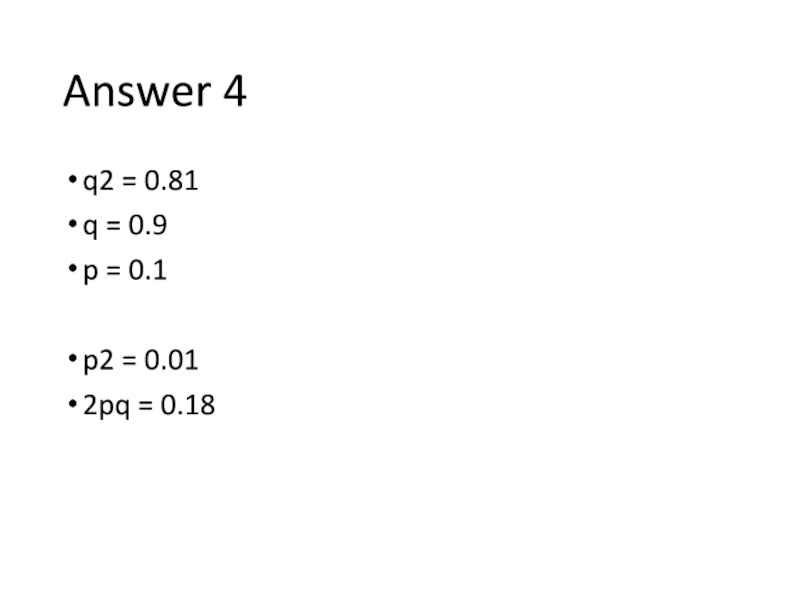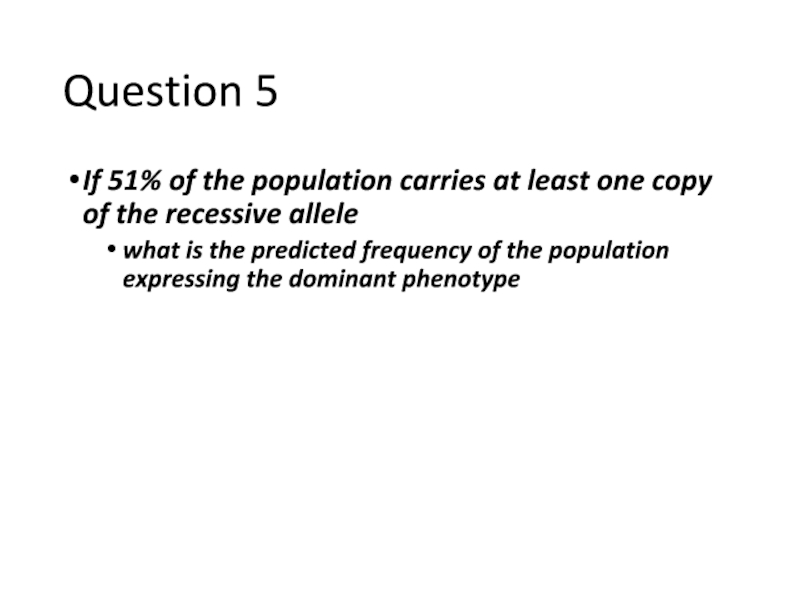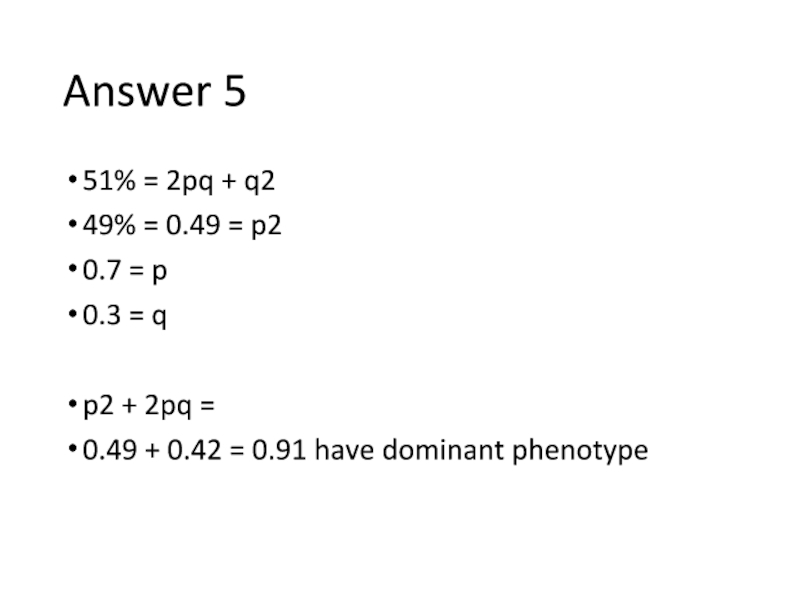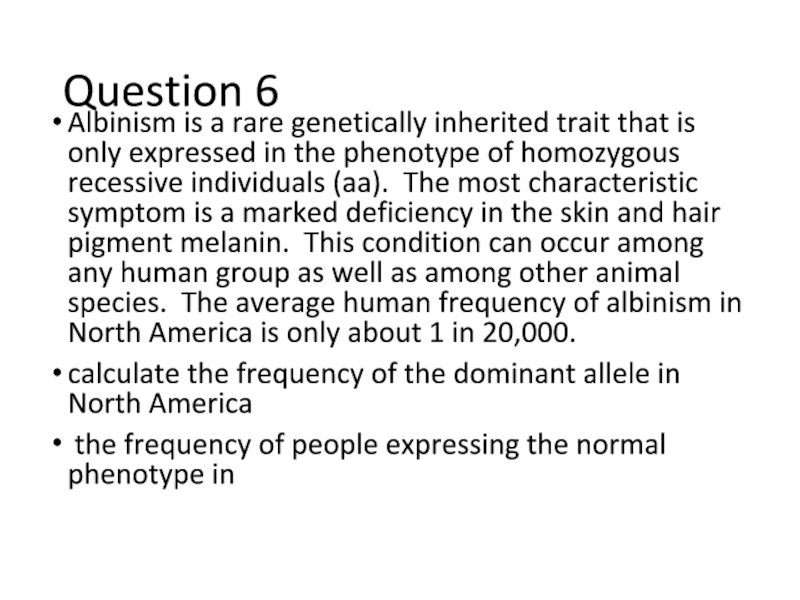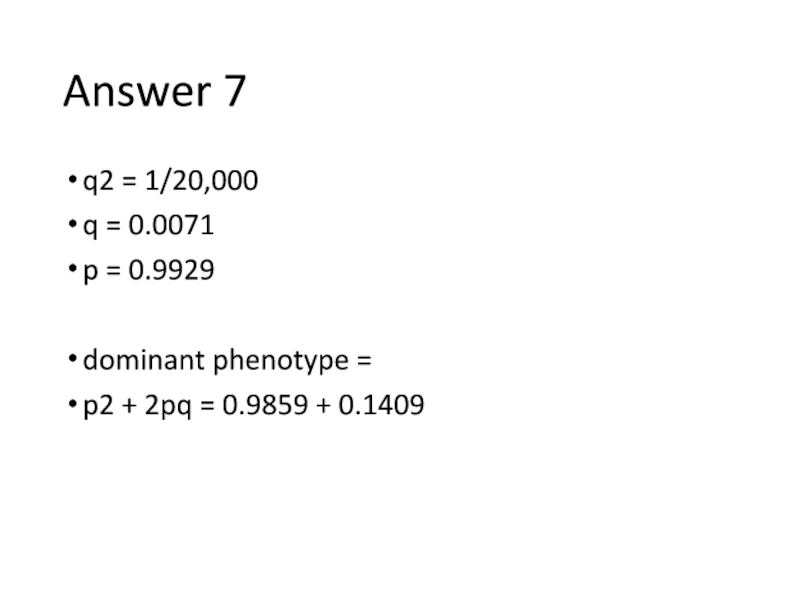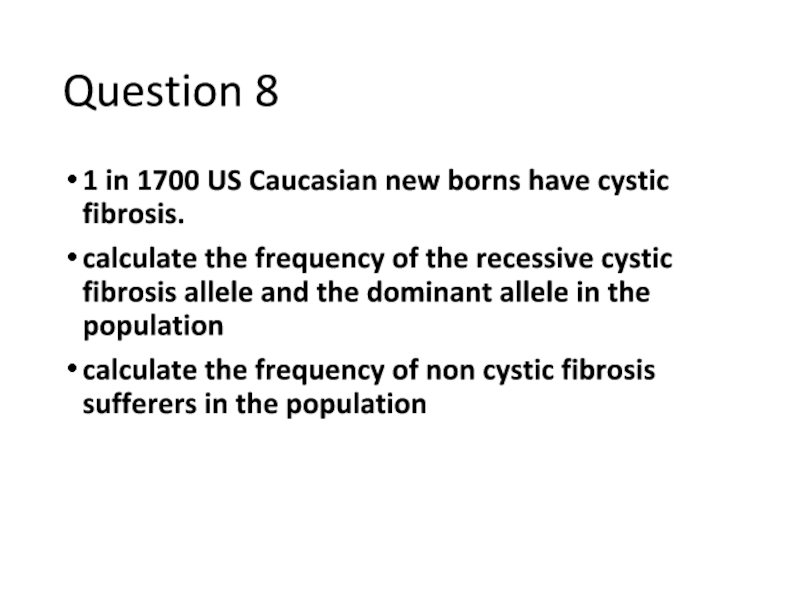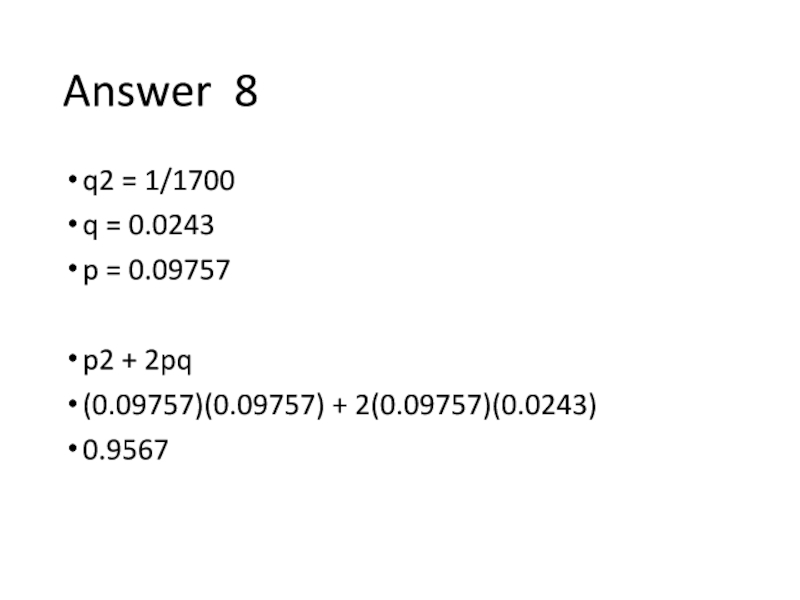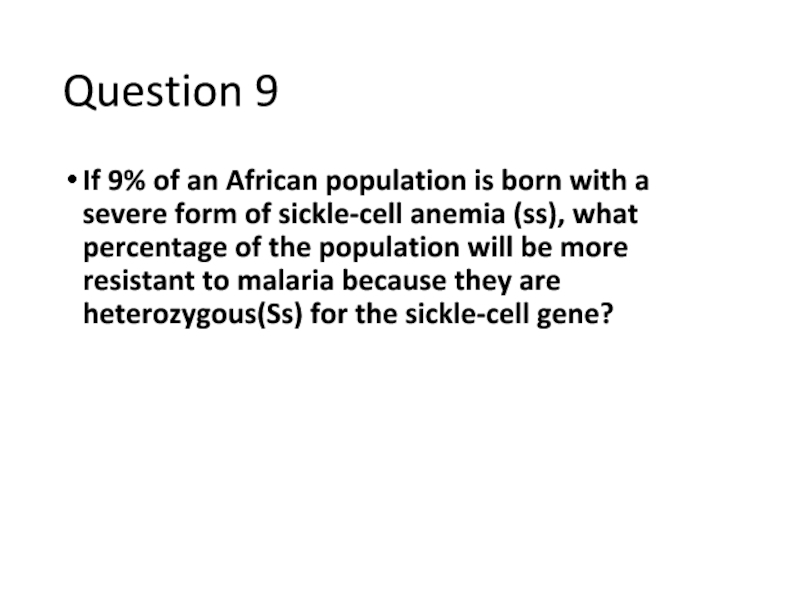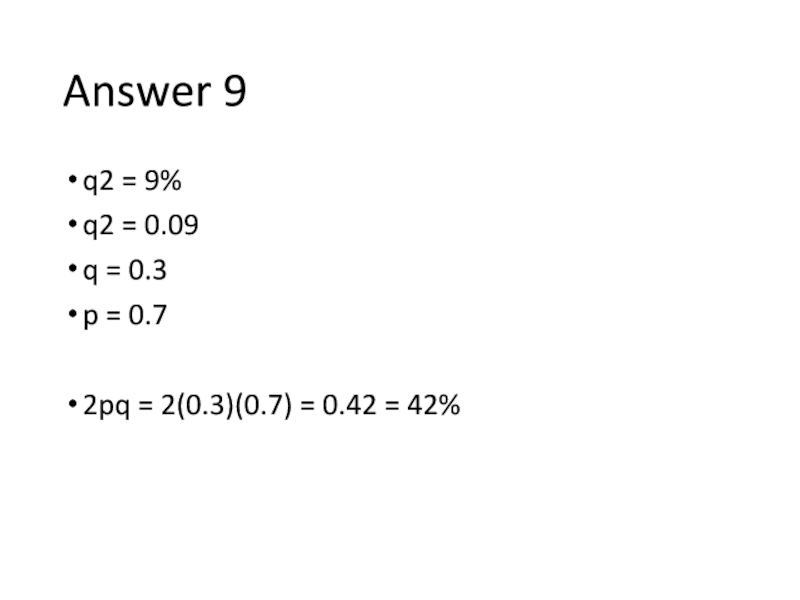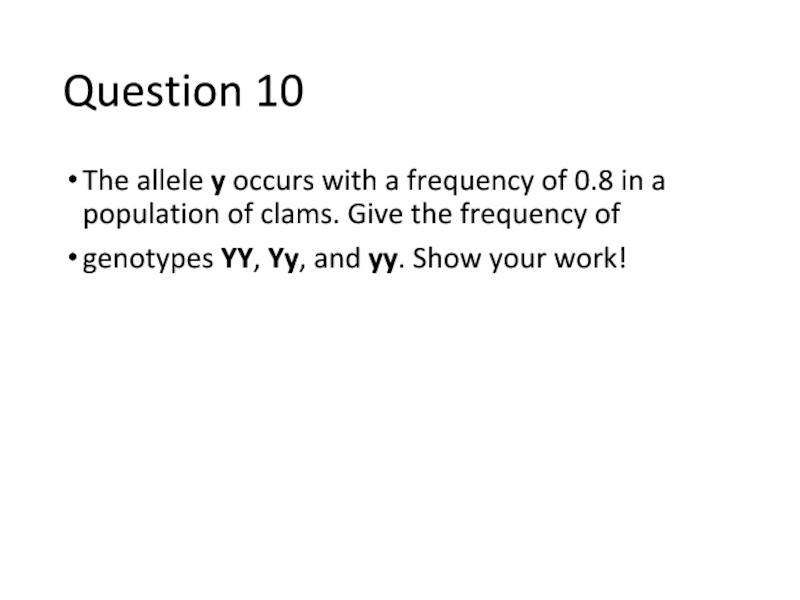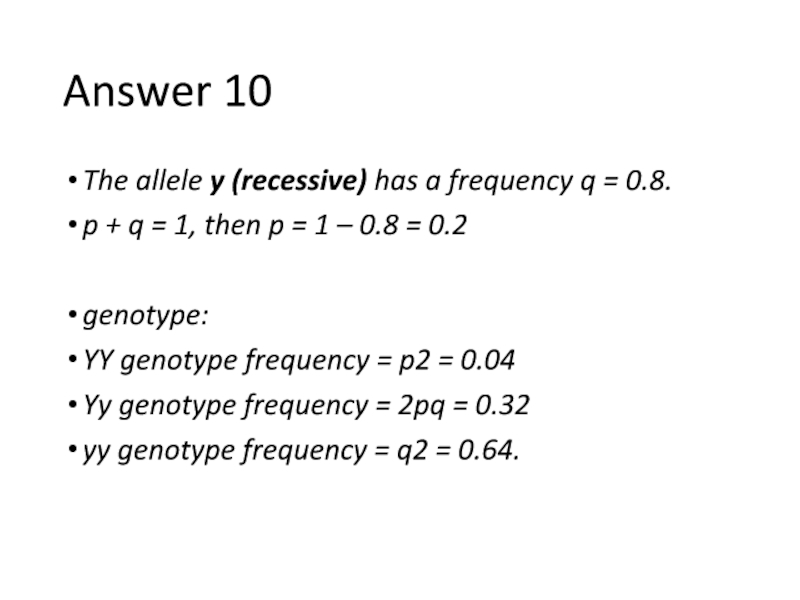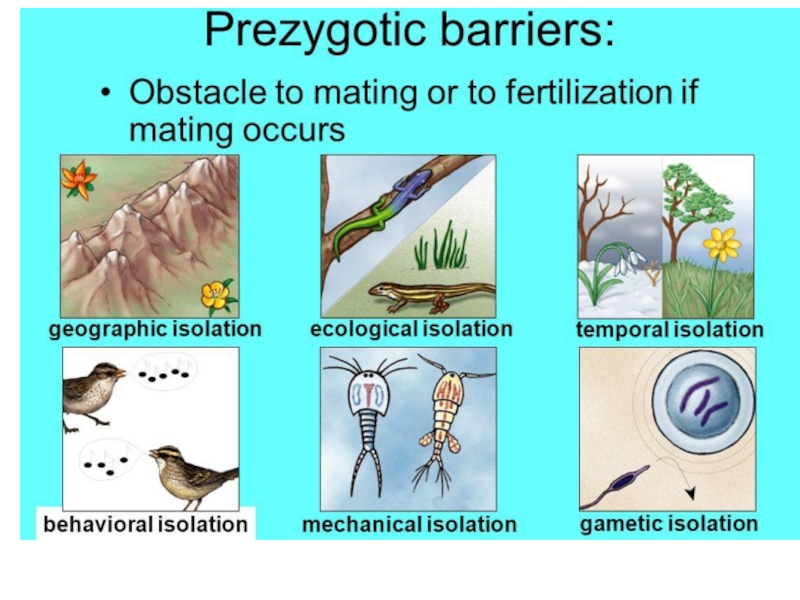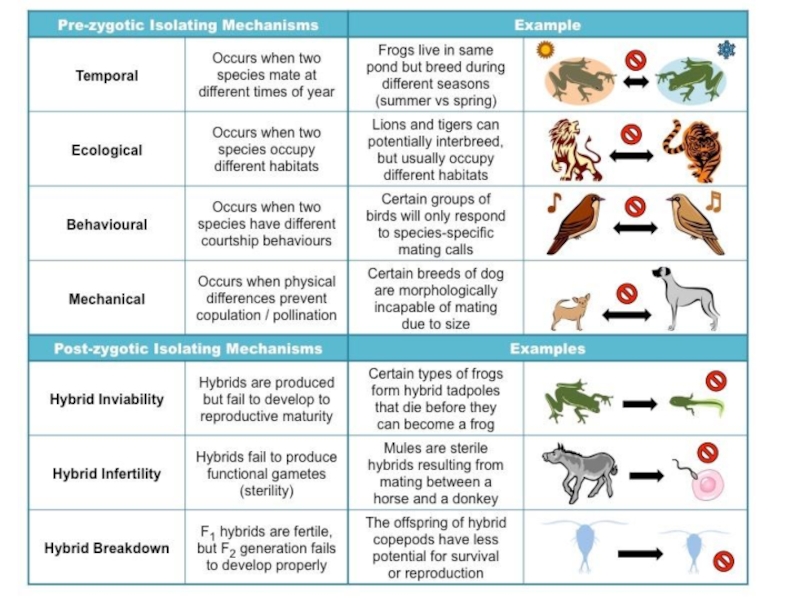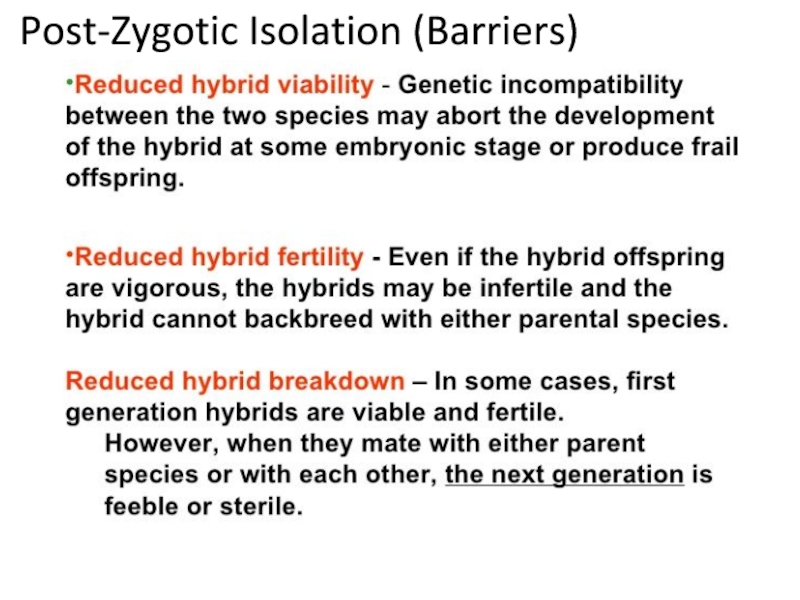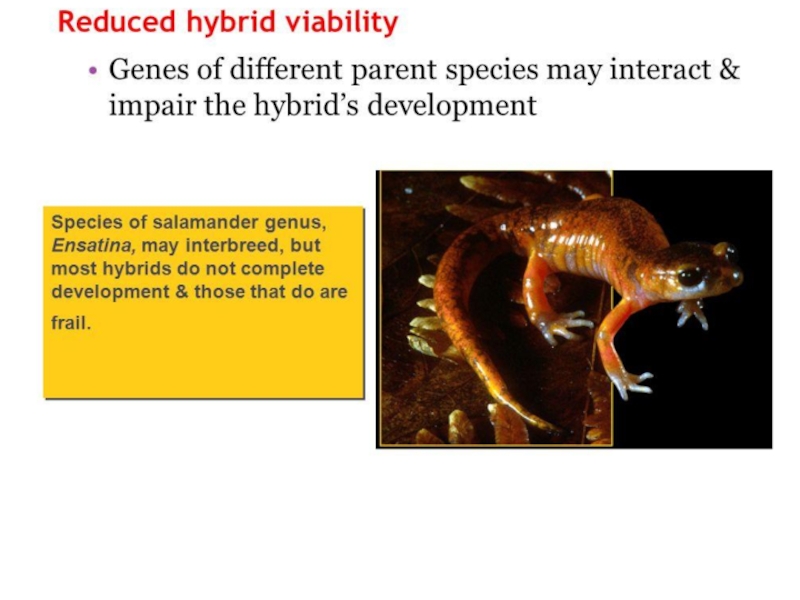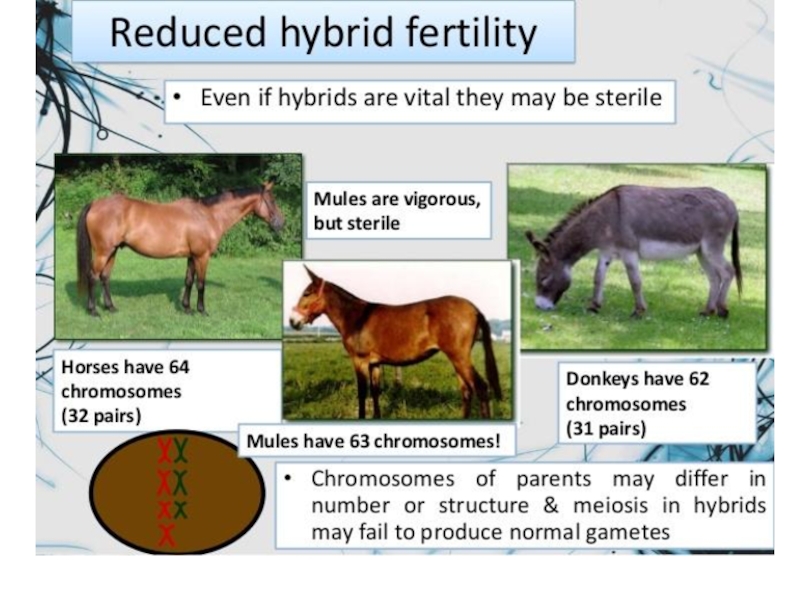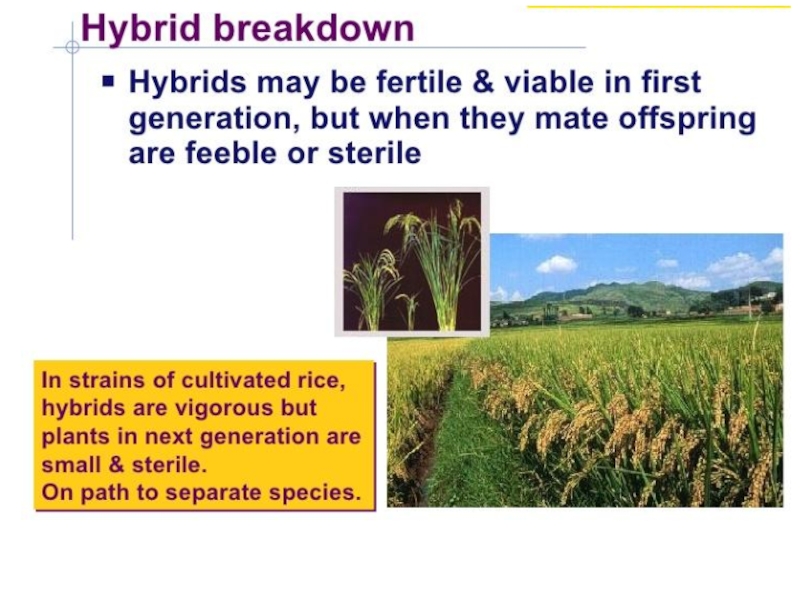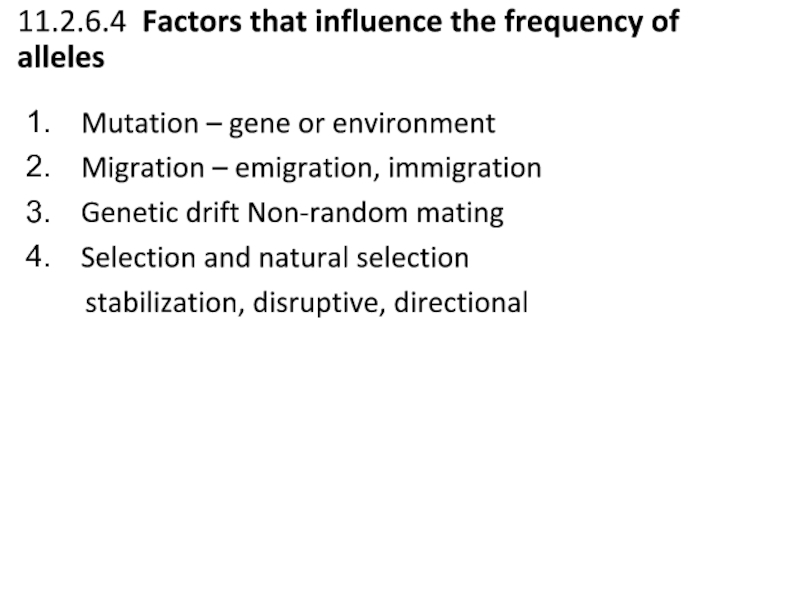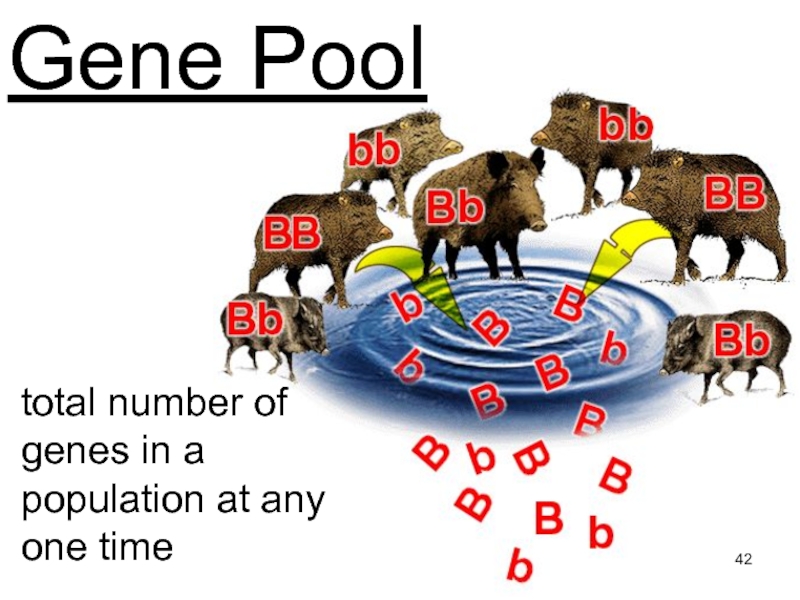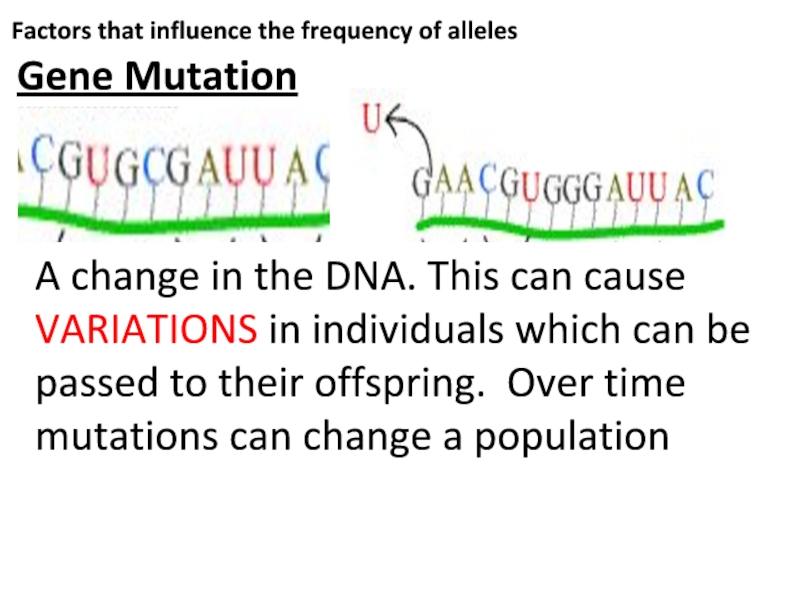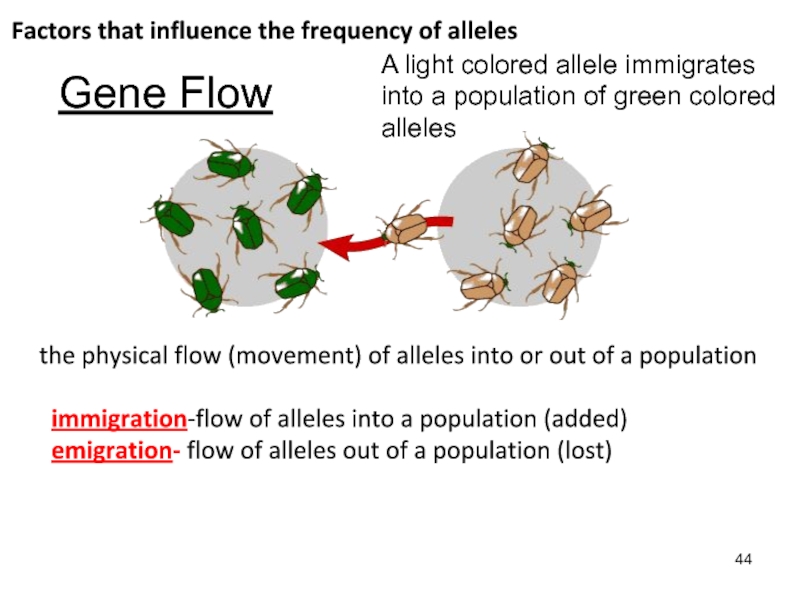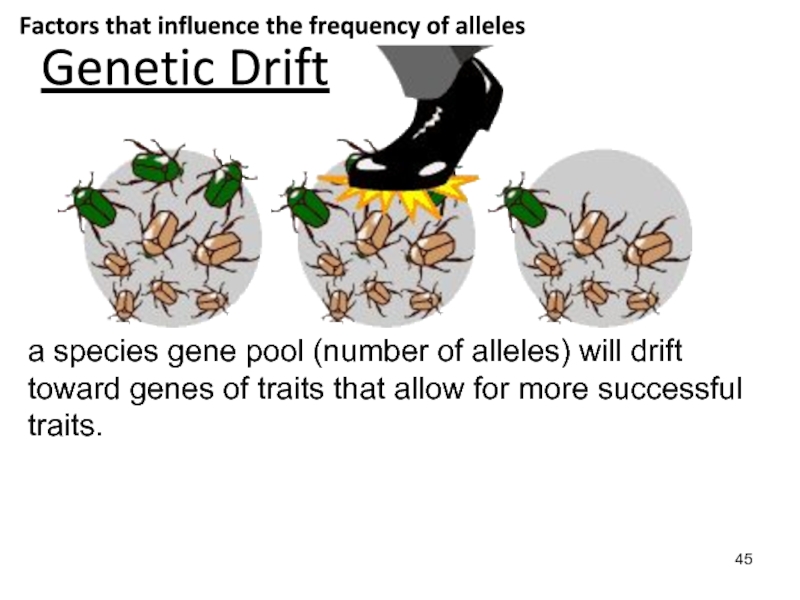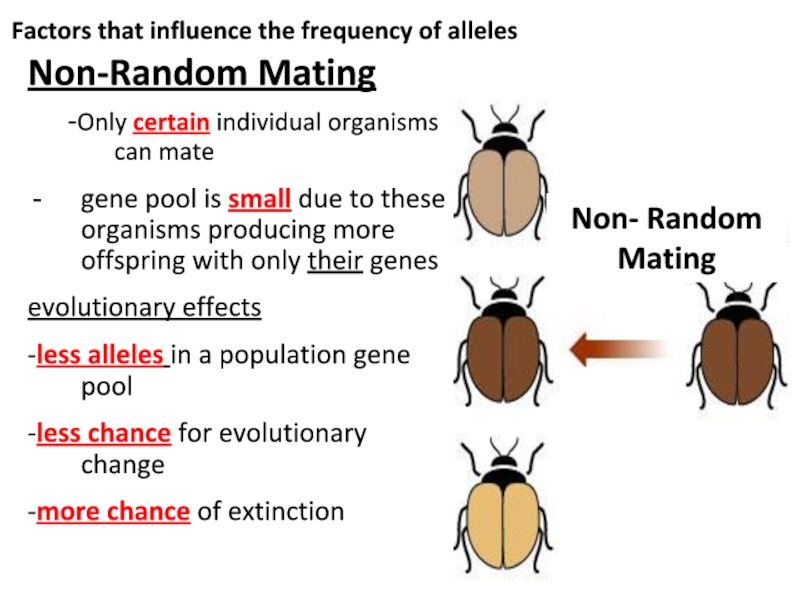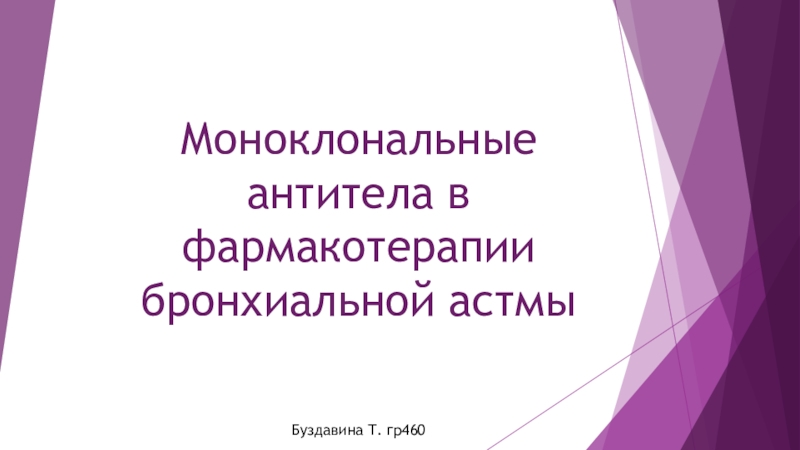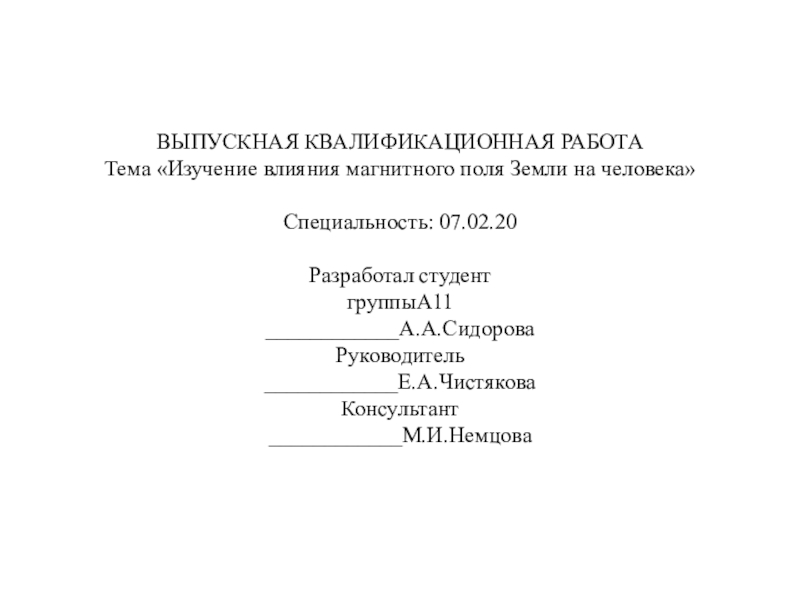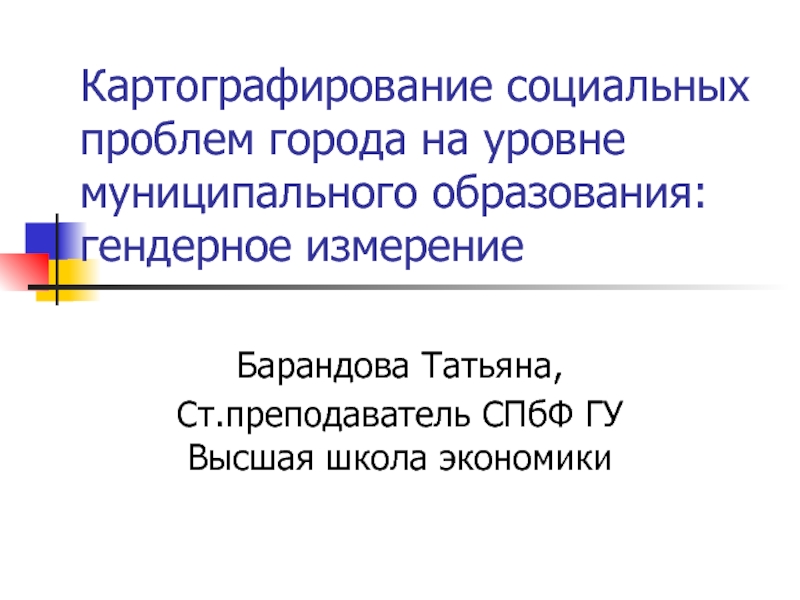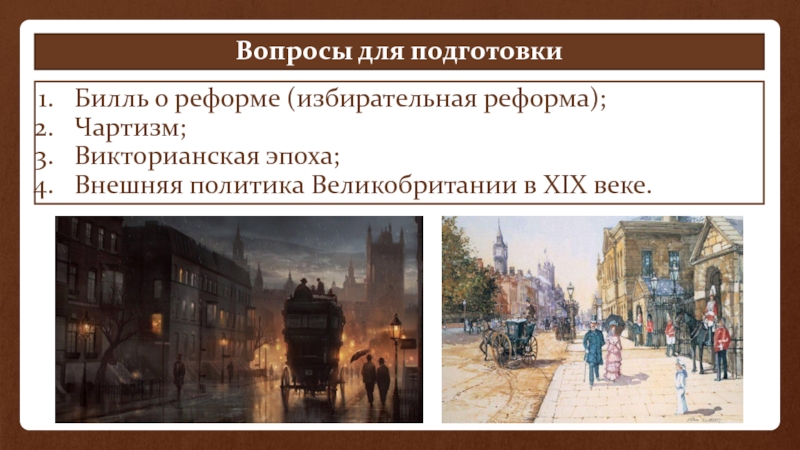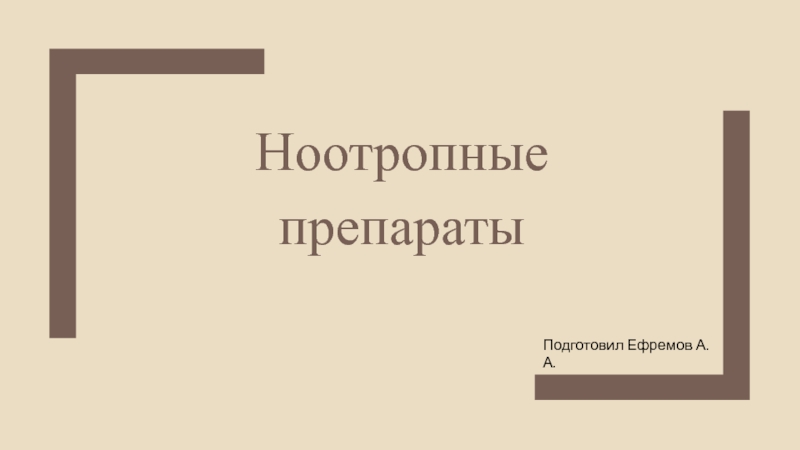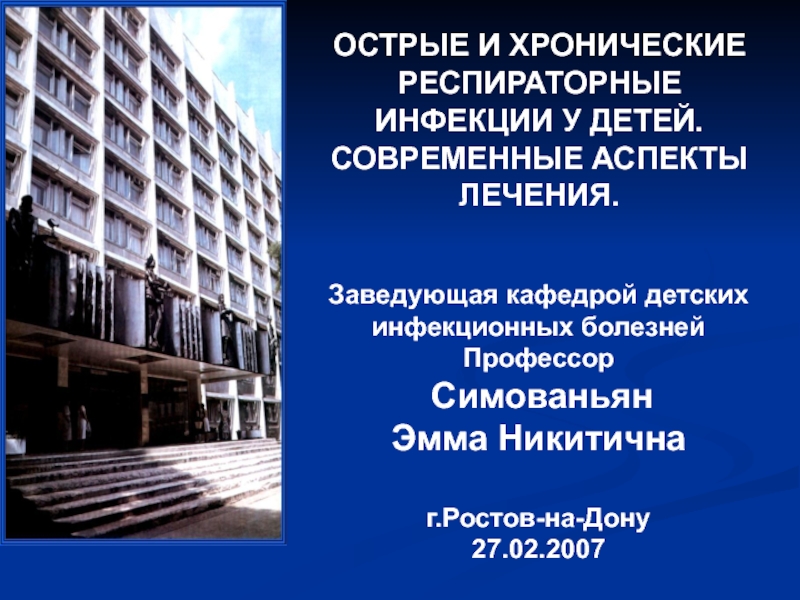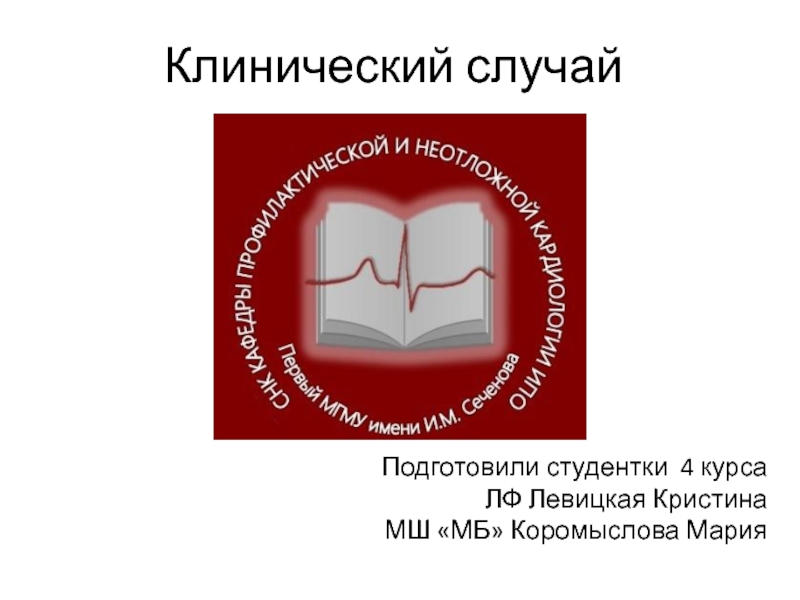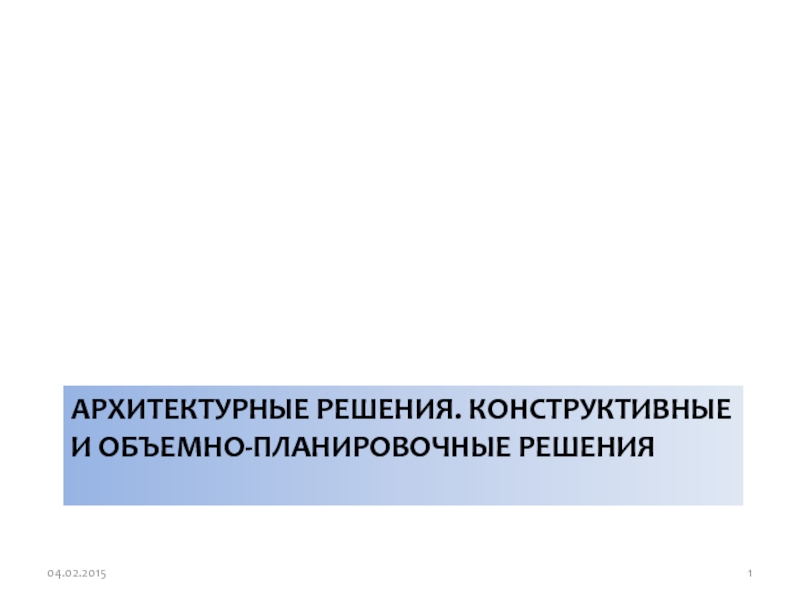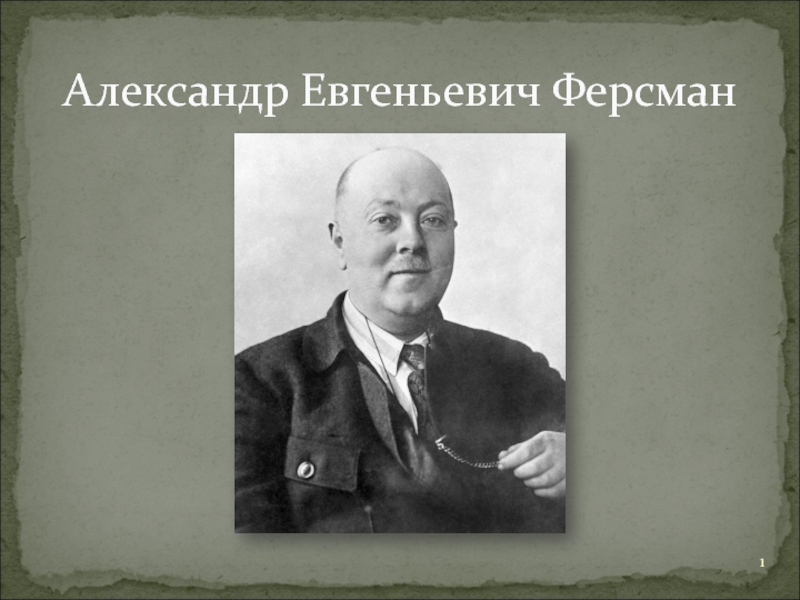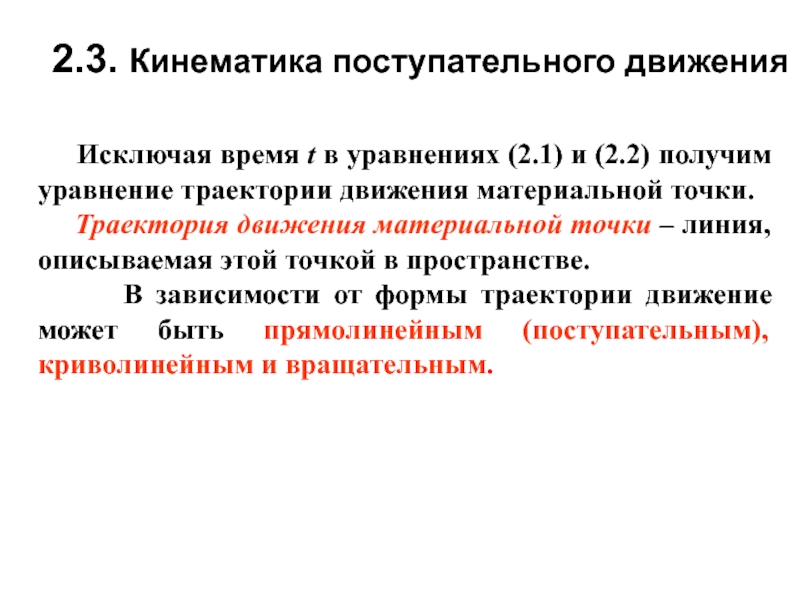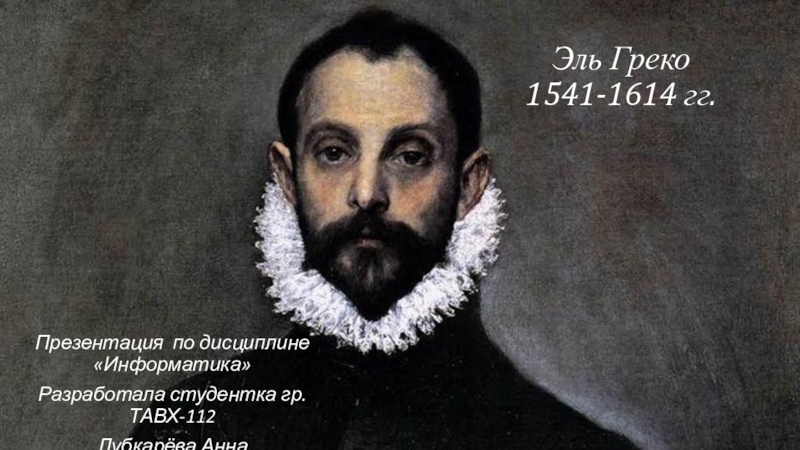Слайд 1G11.4B – Evolution: Hardy Weinberg Theory
Factors that influence the frequency
of genes
Learning Objectives
11.2.6.4 Factors affecting the frequency of alleles
Success
Criteria
1. State and explain the five conditions (factors that influence the frequency of genes) that are used when testing Hardy Weinberg Theory.
2. Work problems of allelic frequency using Hardy Weinberg Theory. factor.
CIE Biology Jones
Bozeman Hardy Weinberg
http://www.bozemanscience.com/hardy-weinberg-equation/
Слайд 2Vocabulary: Frequency of Alleles
Слайд 311.2.6.4 Factors that influence the frequency of alleles
Mutation –
gene or environment
Migration – emigration, immigration
Genetic drift Non-random mating
Selection
and natural selection
stabilization, disruptive, directional
Слайд 4Gene Pool
total number of genes in a population at any
one time
Слайд 5Gene Mutation
A change in the DNA. This can cause VARIATIONS
in individuals which can be passed to their offspring. Over
time mutations can change a population
Factors that influence the frequency of alleles
Слайд 6Gene Flow
A light colored allele immigrates into a population of
green colored alleles
the physical flow (movement) of alleles into or
out of a population
immigration-flow of alleles into a population (added)
emigration- flow of alleles out of a population (lost)
Factors that influence the frequency of alleles
Слайд 7Genetic Drift
a species gene pool (number of alleles) will drift
toward genes of traits that allow for more successful traits.
Factors
that influence the frequency of alleles
Слайд 8Non-Random Mating
Random
Mating
Non- Random
Mating
-Only certain individual organisms can mate
gene
pool is small due to these organisms producing more offspring
with only their genes
evolutionary effects
-less alleles in a population gene pool
-less chance for evolutionary change
-more chance of extinction
Factors that influence the frequency of alleles
Слайд 9Directional
Stabilizing
Disruptive
Selection
Selected for?
Phenotype is selected against /selected for –
changing the population of alleles (genotype)
Selected against?
Factors that influence
the frequency of alleles
Слайд 10Hardy-Weinberg Principle
Starter: The Hardy-Weinberg principle is based on 5
assumptions, use the image above to guess what these could
be. Stretch: Is it truly representative? Why?
Слайд 11The principle predicts allele frequencies wont change between generations
However, this
is only true under certain conditions...
The equations are used to
estimate allele and genotype frequencies within populations
If the frequency of alleles or genotypes do change then one of these must have actually occurred
Слайд 12Hardy-Weinberg
States that the allele frequency for dominant and recessive alleles
remains the same in a population for many generations
if
the following conditions exist:
1. No mutations can occur.
2. The population must be large.
3. All mating must be random
4. No migration can occur.
5. All genotypes must be equal
Слайд 13Allele Frequency
how often an form of a gene shows up
in a population over several generations
the number of copies of
a particular allele divided by the number of copies of all alleles at the genetic place in a population.
Слайд 141. Predicting allele frequency
You can calculate the frequency of
one allele if you know the frequency of the other
allele
Dominant = p and recessive = q
For example, red (R) and white (w) flowers
p + q = 1
If the frequency of R is 0.4, then the frequency of w is?
0.6
Слайд 152. Predicting Genotype frequency
You can calculate the frequency of
one genotype if you know the frequency of the others
P2
= homozygous dominant
2pq = heterozygous
q2 = homozygous recessive
For example, red (R) and white (w) flowers
p2 + 2pq +q2 = 1
If the homozygous red phenotype is 0.34, the heterozygous phenotype is 0.27, what is the frequency of the homozygous white flowers?
1 – 0.34 – 0.27 = 0.39
Слайд 16Cystic fibrosis (ff genotype) in the UK occurs approximately 1
in every 2500 births. Calculate the percentage of carriers in
the UK.
Find q. The homozygous recessive (ff) is q2 in genotype equation.
1 / 2500 = 0.004 = q2
√ of 0.004 = 0.02 = q
Find p.
p + q = 1, so 1 – 0.02 = 0.98 = p
Calculate 2pq
2pq = 2 x (0.98 x 0.02) = 0.039
Remember, 2pq is the heterozygous phenotype (carrier)
This can be expressed as a percentage by multiplying by 100 = 3.9%
0.039 / 1 X 100 = 3.9 %
We can also calculate p2 (homo dominant).
3. Using both equations
p2 + 2pq +q2 = 1
p + q = 1
0.02
0.98
0.039
0.004
0.957
Слайд 17Question 1
If 98 out of 200 individuals in a population
express the recessive phenotype, what percent of the population would
you predict would be heterozygotes?
Слайд 18Answer 1
98/200 = (q2)
0.49 = q2
0.7 = q
p + q
= 1
p = 1 – 0.7
p = 0.3
2pq = 2(0.3)(0.7)
= 0.42 = 42% heterozygotes
Слайд 19Question 2
2. Your original population of 200 was hit by
a tidal wave and 100 organisms were wiped out, leaving
36 homozygous recessive out of the 100 survivors. If we assume that all individuals were equally likely to be wiped out, how did the tidal wave affect the predicted frequencies of the alleles in the population?
Слайд 20Answer 2
36/100 = q2
0.6 = q
p + q = 1
p
= 0.4
Heterozygous = 2 (0.4)(0.6) = 0.48 = 48%
Homozygous dominant
= (0.4)(0.4) = 0.16 = 16%
Слайд 21Question 3
Lets say that brown fur coloring is dominant to
grey fur coloring in mice. If you have 168 brown
mice in a population of 200 mice........
What is the predicted frequency of
Homozygous dominants
Heterozygotes
Homozygous recessives
Слайд 22Answer 3
200 mice in total
168 = brown = p2 +
2pq
32/200 = grey fur = q2
0.16 = q2
0.4 = q
p
= 0.6 (p + q = 1)
p2 = 0.36 = 36%
2pq = 0.48 = 48%
q2 = 0.16 = 16%
Слайд 23Question 4
If 81% of a population is homozygous recessive for
a given trait. Calculate
Frequency of homozygous dominant
Frequency of heterozygotes
Frequency of
dominant and recssive alleles
Слайд 24Answer 4
q2 = 0.81
q = 0.9
p = 0.1
p2 = 0.01
2pq
= 0.18
Слайд 25Question 5
If 51% of the population carries at least
one copy of the recessive allele
what is the predicted frequency
of the population expressing the dominant phenotype
Слайд 26Answer 5
51% = 2pq + q2
49% = 0.49 =
p2
0.7 = p
0.3 = q
p2 + 2pq =
0.49 + 0.42
= 0.91 have dominant phenotype
Слайд 27Question 6
Albinism is a rare genetically inherited trait that
is only expressed in the phenotype of homozygous recessive individuals
(aa). The most characteristic symptom is a marked deficiency in the skin and hair pigment melanin. This condition can occur among any human group as well as among other animal species. The average human frequency of albinism in North America is only about 1 in 20,000.
calculate the frequency of the dominant allele in North America
the frequency of people expressing the normal phenotype in
Слайд 28Answer 7
q2 = 1/20,000
q = 0.0071
p = 0.9929
dominant phenotype
=
p2 + 2pq = 0.9859 + 0.1409
Слайд 29Question 8
1 in 1700 US Caucasian new borns have
cystic fibrosis.
calculate the frequency of the recessive cystic fibrosis
allele and the dominant allele in the population
calculate the frequency of non cystic fibrosis sufferers in the population
Слайд 30Answer 8
q2 = 1/1700
q = 0.0243
p = 0.09757
p2 + 2pq
(0.09757)(0.09757)
+ 2(0.09757)(0.0243)
0.9567
Слайд 31Question 9
If 9% of an African population is born
with a severe form of sickle-cell anemia (ss), what percentage
of the population will be more resistant to malaria because they are heterozygous(Ss) for the sickle-cell gene?
Слайд 32Answer 9
q2 = 9%
q2 = 0.09
q = 0.3
p =
0.7
2pq = 2(0.3)(0.7) = 0.42 = 42%
Слайд 33Question 10
The allele y occurs with a frequency of 0.8
in a population of clams. Give the frequency of
genotypes YY,
Yy, and yy. Show your work!
Слайд 34Answer 10
The allele y (recessive) has a frequency q
= 0.8.
p + q = 1, then p = 1
– 0.8 = 0.2
genotype:
YY genotype frequency = p2 = 0.04
Yy genotype frequency = 2pq = 0.32
yy genotype frequency = q2 = 0.64.
Слайд 37Post-Zygotic Isolation (Barriers)
Слайд 4111.2.6.4 Factors that influence the frequency of alleles
Mutation –
gene or environment
Migration – emigration, immigration
Genetic drift Non-random mating
Selection
and natural selection
stabilization, disruptive, directional
Слайд 42Gene Pool
total number of genes in a population at any
one time
Слайд 43Gene Mutation
A change in the DNA. This can cause VARIATIONS
in individuals which can be passed to their offspring. Over
time mutations can change a population
Factors that influence the frequency of alleles
Слайд 44Gene Flow
A light colored allele immigrates into a population of
green colored alleles
the physical flow (movement) of alleles into or
out of a population
immigration-flow of alleles into a population (added)
emigration- flow of alleles out of a population (lost)
Factors that influence the frequency of alleles
Слайд 45Genetic Drift
a species gene pool (number of alleles) will drift
toward genes of traits that allow for more successful traits.
Factors
that influence the frequency of alleles
Слайд 46Non-Random Mating
Random
Mating
Non- Random
Mating
-Only certain individual organisms can mate
gene
pool is small due to these organisms producing more offspring
with only their genes
evolutionary effects
-less alleles in a population gene pool
-less chance for evolutionary change
-more chance of extinction
Factors that influence the frequency of alleles

